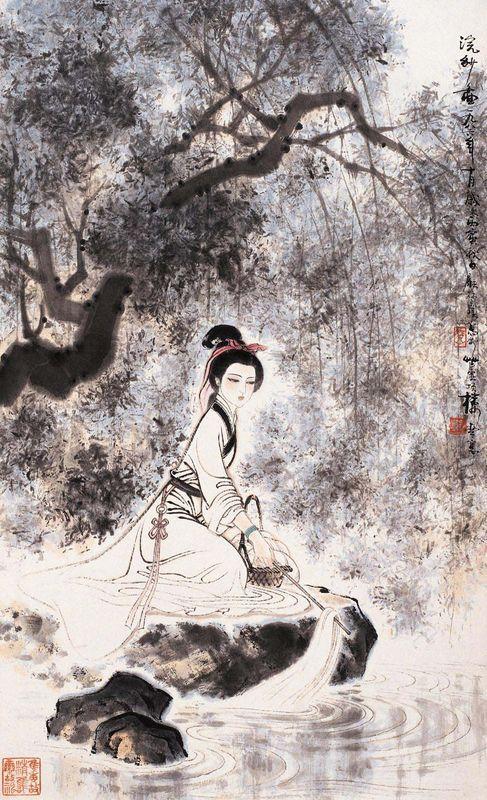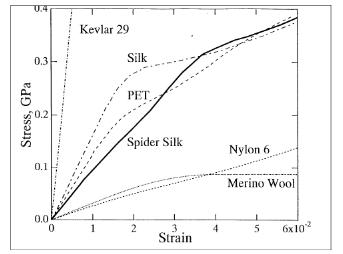Team:Groningen/Project
From 2013.igem.org
| Home | Team | Official Team Profile | Project | Parts Submitted to the Registry | Modeling | Notebook | Safety | Attributions |
|---|
Contents |
Night or Day, Silk is the way xD
small intro here
The origin of silk
Ancient Chinese legend has it that a princess named Xi Ling Shi, who was having a relaxing afternoon under a Mulberry tree, first discovered silk 4500 years ago when a cocoon suddenly fell in her tee. After some time, Xi Ling Shi extracted a silk thread from her still steaming cup of thee, and unraveled the secret of silk along with its cocoon.
The knowledge that silk could be extracted from insect cocoons was closely guarded, and harsh conditions were set (the penalty of death) to anyone who was caught smuggling the eggs or cocoons. By such means, China realized a two thousand year monopoly of the silk industry, which was, according to yet another legend, put to an end when a Chinese princess smuggled moth eggs and mulberry seeds as a gift for her future husband. Subsequent to the princesses betrayal, the secret of silk was still kept secret from the west for another good thousand years or so, as it was only in the 12th century ACE that sericulture (the production of silk) began to develop.
Silk has thus inspired many legends and myths. Whether the stories are true or not, it is a fact that the discovery of silk has had world-wide impacts on culture, economy, development, and trade due to its much desired properties.
Princess Xi Ling Shi. [3]
The properties of silk
The unique properties of silk are a result of its highly constant and repetitive amino-acid structure. The sequence of amino-acids determines what secondary structures will arise, and thus the final preferred protein conformation. The secondary structures may be beta sheets, beta-spirals, and beta-helices, of which the sheets realize the silk's amazing tensile strength, and the spirals and helices its elongation.
In the figure below a stress-strain diagram can be found (Frank K. Ko, et at. 2001) where Clavipus spider silk is compared to, Kevlar 29, normal silkworm silk, PET (polyethylene terephthalate), Nylon 6, and Merino wool. The stress-strain diagram relates the degree of deformation to the amount of energy absorbed.
When used as clothing, silk has many beneficial properties. Its smooth, compact surface feels and looks nice, and it enables easy removal of dirt. It is a bad conductor of heat, making it cool in the summer and warm in the winter. Furthermore, it has a water absorption efficiency similar to that of wool, and is resistant to insects and mildew.
A final general property of silk it that it can be integrated with the human body - it will not induce an immune response - potentially making it an ideal choice for many biomedical applications. Its compatibility extends to the gastrointestinal tract, that is, it is even safe to eat!
The production of silk
The farming of silk is an arduous, time consuming, and costly process. Although a single cocoon may produce up to one mile of filament, 4 to 8 filaments are needed to produce a single thread, and approximately 5500 cocoons are needed for one kilogram of silk. Eight fully grown mulberry trees would have been needed for this single kilogram, and 48 hours of man-labor required to hand-reel it. Finally, the caterpillars required a full month to mature and three to five days to spin their cocoons, after which they were brutally boiled alive. Harvesting the more desired and rare silk from spiders requires an even more labor-extensive process. Each thread actually has to be pulled individually by hand from the spiders gland - needless to say, not a viable business plan!
The silk industry itself has undergone very little development over the past few millennia. Indeed, the manner in which it is obtained follows the very same process as that of princes Xi Ling Shi's initial discovery, albeit at a much grander scale with more specialized equipment. Scientists have therefore begun to design their own silk producing organisms [2]. Moreover, the 2012 iGEM team from Utah successfully designed the first spider-silk producing Biobricks for Escherichia coli (for more information, please visit their wiki). Such advancements are needed to provide the industries and manufacturers with sufficient silk proteins for their applications.
Applications for silk
Silk's journey as a product began as luxurious clothing reserved exclusively for the emperor subsequent to its initial discovery. As the sericulture developed, however, it was soon adopted by all classes of society. New applications were discovered, and it was spun into many different products; fishing lines, musical instruments, and bowstrings to name a few. It's utility and value were also recognized by other kingdoms, and a world-wide, ever increasing demand for the material began. Indeed, the western demand for silk was so great, that the main set of trade routes between Europe and Asia became known as the Silk Road.
.... Nowadays, the variety of silk applications is even more extensive; bullet-proof clothing, all sorts of ropes and cables, artificial tendons and ligaments, bandages, sewing thread, seat belts, parachutes, biodegradable bottles, and much more.....
References
[1] Frank K. Ko, et al, (2001). "Engineering properties of spider silk". MRS Proceedings, vol. 702
[2] Charlotte Vendrely & Thomas Scheibel, (2007). Biotechnological production of spider-silk proteins enables new applications. Macromol. Biosci, vol 7, pp 401-409.
[3] Current online source. Waiting for author for more details.
Heat Motility
In case of a low yield we want a targeted secretion only near our (that we want to coat with silk). In order to achieve this we want to have a bacillus that will move towards heat. If the implant is heated it will attract our silk secreting bacillus.
The cold sensor DesK
Use of DesK as an sensor for temperature. DesK is a membrane protein (a kinase), it is part of a cascade that has to maintain the membrane liquidity. It does this by phosphorylating DesR, this phosphorylated DesR activates a promotor (pdes) that expresses the des gene, changing the membrane in the process. The article mentions that DesK is most active onces the temperature drops below 30 C, however the autokinase activity is still present at 42 C though drastically less. DesK is a real cold sensor, which is natively present in bacillus. We want to use the DesK in our heat sensing construct (how we do this is under motility), by PCR'ing the pdes promotor out of B. subtilis and Hereby activating the motility gene that we fuse after it.
References
Regulation of Bacillus subtilis DesK thermosensor by lipids , Mariana MART ́N1 and Diego DE MENDOZA2 , Biochem. J. (2013) 451, 269–275
Motility
The motility part of our construct is based on two articles, a very old (1995) article with general information about motility and a newer one focusing on the attractant/repellent sensor cascade.
General:
Bacterial movement based on flagella (tail like structures) and utilizes CCW(counter-clockwise) and CW (clockwise) movement. When the flagella spin CCW they gather in one area resulting in bacteria that move strait. When the flagella move CW they disperse all over the cell membrane, resulting in the bacteria spinning in random directions (tumbling). When the bacteria senses an attractant it will go CCW, till the concentration gets lower after which it will go CW resulting in a change in direction. Bacteria will move towards attractants and away from repellents.
The receptor and our Idea:
The receptor is displayed in the figure on the page below. The letters are all Che proteins, with this cascade of proteins motility is coordinated. When a attractant is bound to the receptor, CheA phosphorylizes CheY into CheY-P. CheY-P causes the CCW motility in the flagella, it also causes (by forming a CheY-p/CheC complex) that CheD is pulled off the receptor. CheD and CheC forms also a complex which dephosphorylizes CheY-p into CheY thus resetting the receptor. What we want is to knock out the natively CheY gene, which the article from 1995 mentions so it is possible. And then fuse a CheY gene to the pdes promoter. The result is that CheY is only present when the temperature is low (below 30 C). Causing a very particular movement, two ways of movements are theorized.
Claudio's theory:
The DesK activates when cold, so the bacteria could swim forward when it is still cold. This is dependent on the fact if the attractant receptor is bound at the moment of expression of CheY. Causing a pseudo random movement. As soon as it gets warmer the bacteria will stop being able to move cause no CheY will be present, therefore staying in place. The result will be a bacteria that will stay in a warmer area’s, cause as soon it gets cold again it will be able to move again.
Inne's theory:
The pseudo random movement claudio proposes is correct, however could be improved by continually stimulating a repellent receptor. This will cause the Bacillus to move away as soon it gets into a cold area. It guarantees that CheY will be phosphorylated as soon as it is transcribed/ translated, and therefore the bacteria can move. Both systems are not directly influencing movement, but cause the organism to have a bias towards warmer area's. Note: chemotaxis is kind of confusing when applied to different organisms, e.coli for example uses the same proteins but they have the effect of these proteins is the total opposite. Namely CheY causing tumbling.
References
The three adaptation systems of Bacillus subtilis chemotaxis , Christopher V. Rao1, George D. Glekas2 and George W. Ordal2 , 2008 Elsevier Ltd. All rights reserved. CHEMOTAXIS IN BACILLUS SUBTILIS: HOW BACTERIA MONITOR ENVIRONMENTAL SIGNALS, LIAM F. GARRITY and GEORGE W. ORDAL* , Pharmac. Ther. Vol. 68 No.1 pp. 87-104, 1995
The Silk Biofilm
to be continued da-da-da-dhaaaam
Method/experiments
Results/conclusion, etc
References
 "
"

